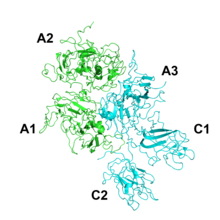Factor VIII (medication)
 A depiction of factor VIII | |
| Clinical data | |
|---|---|
| Trade names | Aafact, Kovaltry, others[1] |
| Other names | octocog alfa |
| AHFS/Drugs.com | Monograph |
| Routes of administration | Intravenous (IV) |
| ATC code | |
| Legal status | |
| Legal status |
|
| Identifiers | |
| ChemSpider |
|
Factor VIII is a medication used to treat and prevent bleeding in people with hemophilia A and other causes of low factor VIII.[2][3] Certain preparations may also be used in those with von Willebrand's disease.[3] It is given by slow injection into a vein.[2]
Side effects include skin flushing, shortness of breath, fever, and red blood cell breakdown.[2][3] Allergic reactions including anaphylaxis may occur.[3] It is unclear if use during pregnancy is safe for the baby.[4] A purified factor VIII concentrate is made from human blood plasma.[3] A recombinant version is also available.[2] People may develop antibodies to factor VIII such that this medication becomes less effective.[4]
Factor VIII was first identified in the 1940s and became available as a medication in the 1960s.[5][6] Recombinant factor VIII was first made in 1984 and approved for medical use in the United States in 1992.[7][8] It is on the World Health Organization's List of Essential Medicines, the safest and most effective medicines needed in a health system.[9] The wholesale cost in the developing world is about US$119–497 per 500 IU vial.[10]
History
This transfer of a plasma byproduct into the blood stream of a hemophiliac often led to the transmission of diseases such as HIV and hepatitis before purification methods were improved. In the early 1990s, pharmaceutical companies began to produce recombinant synthesized factor products, which now prevent nearly all forms of disease transmission during replacement therapy.
References
- ^ "Coagulation Factor VIII, Human". www.drugs.com. Archived from the original on 9 January 2017. Retrieved 8 January 2017.
- ^ a b c d World Health Organization (2009). Stuart MC, Kouimtzi M, Hill SR (eds.). WHO Model Formulary 2008. World Health Organization. pp. 259–60. hdl:10665/44053. ISBN 9789241547659.
- ^ a b c d e British National Formulary : BNF 69. British Medical Association. 2015. p. 171. ISBN 978-0857111562.
- ^ a b "Alphanate – Summary of Product Characteristics (SPC) – (eMC)". www.medicines.org.uk. Archived from the original on 9 January 2017. Retrieved 8 January 2017.
- ^ Potts, D.M. (2011). Queen Victoria's Gene: Haemophilia and the Royal Family (Chapter 5). The History Press. ISBN 978-0752471969. Archived from the original on 2017-01-09.
- ^ Sibinga, Cees Smit; Das, P.C.; Overby, L.R. (2012). Biotechnology in blood transfusion: Proceedings of the Twelfth Annual Symposium on Blood Transfusion, Groningen 1987, organized by the Red Cross Blood Bank Groningen-Drenthe. Springer Science & Business Media. p. 224. ISBN 978-1461317616. Archived from the original on 2017-01-09.
- ^ Buckel, P. (2012). Recombinant Protein Drugs. Birkhäuser. p. 79. ISBN 978-3034883467. Archived from the original on 2017-01-09.
- ^ Hillyer, Christopher D. (2006). Blood Banking and Transfusion Medicine: Basic Principles & Practice. Elsevier Health Sciences. p. 353. ISBN 0443069816. Archived from the original on 2017-01-09.
- ^ World Health Organization (2019). World Health Organization model list of essential medicines: 21st list 2019. Geneva: World Health Organization. hdl:10665/325771. WHO/MVP/EMP/IAU/2019.06. License: CC BY-NC-SA 3.0 IGO.
- ^ "Factor Viii". International Drug Price Indicator Guide. Retrieved 8 December 2016.
External links
- "Blood-coagulation factor VIII, procoagulant". Drug Information Portal. U.S. National Library of Medicine.
- "Beroctocog alfa". Drug Information Portal. U.S. National Library of Medicine.
- "Antihemophilic Factor (Recombinant) Monograph for Professionals". Drugs.com.
- "Antihemophilic Factor (Recombinant), Porcine Sequence Monograph for Professionals". Drugs.com.
- "Antihemophilic Factor (recombinant), Fc Fusion Protein Monograph for Professionals". Drugs.com.
- "Antihemophilic Factor (recombinant), Glycopegylated-exei Monograph for Professionals". Drugs.com.
